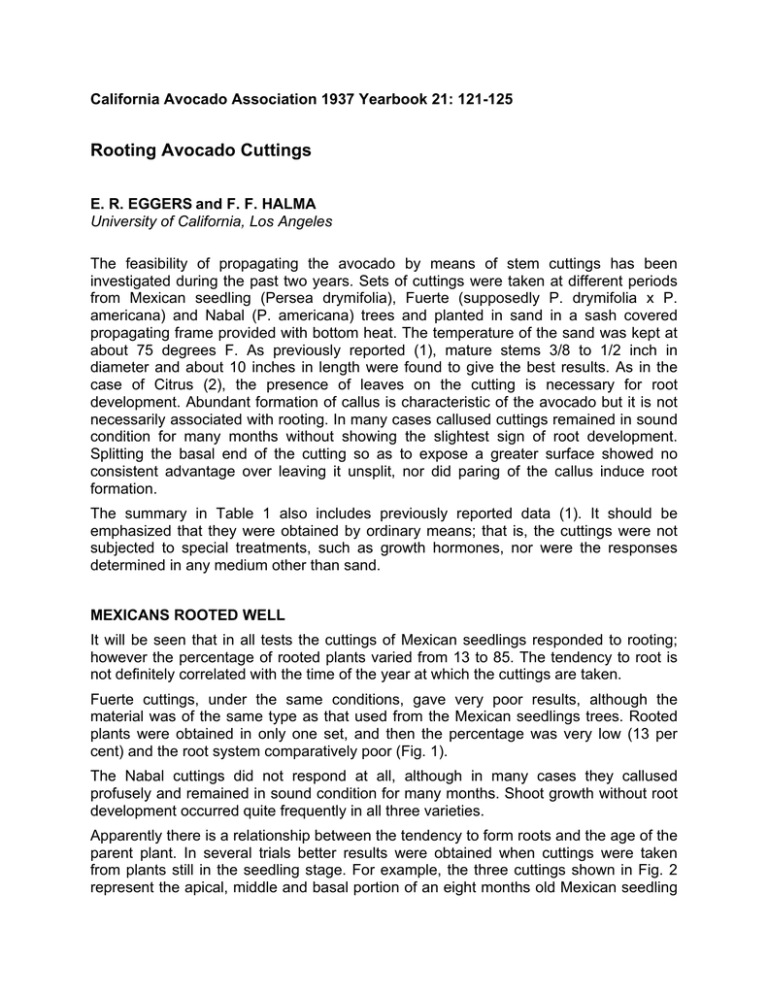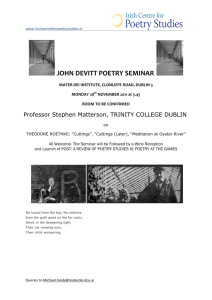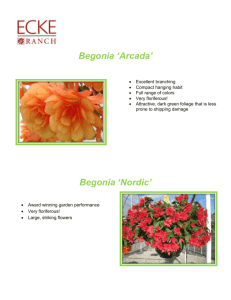Rooting Avocado Cuttings
advertisement

California Avocado Association 1937 Yearbook 21: 121-125 Rooting Avocado Cuttings E. R. EGGERS and F. F. HALMA University of California, Los Angeles The feasibility of propagating the avocado by means of stem cuttings has been investigated during the past two years. Sets of cuttings were taken at different periods from Mexican seedling (Persea drymifolia), Fuerte (supposedly P. drymifolia x P. americana) and Nabal (P. americana) trees and planted in sand in a sash covered propagating frame provided with bottom heat. The temperature of the sand was kept at about 75 degrees F. As previously reported (1), mature stems 3/8 to 1/2 inch in diameter and about 10 inches in length were found to give the best results. As in the case of Citrus (2), the presence of leaves on the cutting is necessary for root development. Abundant formation of callus is characteristic of the avocado but it is not necessarily associated with rooting. In many cases callused cuttings remained in sound condition for many months without showing the slightest sign of root development. Splitting the basal end of the cutting so as to expose a greater surface showed no consistent advantage over leaving it unsplit, nor did paring of the callus induce root formation. The summary in Table 1 also includes previously reported data (1). It should be emphasized that they were obtained by ordinary means; that is, the cuttings were not subjected to special treatments, such as growth hormones, nor were the responses determined in any medium other than sand. MEXICANS ROOTED WELL It will be seen that in all tests the cuttings of Mexican seedlings responded to rooting; however the percentage of rooted plants varied from 13 to 85. The tendency to root is not definitely correlated with the time of the year at which the cuttings are taken. Fuerte cuttings, under the same conditions, gave very poor results, although the material was of the same type as that used from the Mexican seedlings trees. Rooted plants were obtained in only one set, and then the percentage was very low (13 per cent) and the root system comparatively poor (Fig. 1). The Nabal cuttings did not respond at all, although in many cases they callused profusely and remained in sound condition for many months. Shoot growth without root development occurred quite frequently in all three varieties. Apparently there is a relationship between the tendency to form roots and the age of the parent plant. In several trials better results were obtained when cuttings were taken from plants still in the seedling stage. For example, the three cuttings shown in Fig. 2 represent the apical, middle and basal portion of an eight months old Mexican seedling with cotyledons still attached. This would suggest that the cotyledons may furnish the plant with some substance essential to root formation. Further evidence in support of this view was obtained with stems of Fuerte seedlings. The seeds were planted in February 1937 in the propagating frame and heat was applied to hasten germination. Two months later ten of the resulting sprouts were cut off close to the surface of the sand and placed in the same frame. These sprouts were then 8 to 10 inches in length and immature, with leaves only partly developed. Nine of them rooted within five weeks. The range in root development is shown in Fig. 3a. The rapid development of the root system one month later as the result of the plants having been potted in good soil is shown in Fig. 3b. Some of the plants were planted in the nursery, and at the time of writing this report (September 1937) they are making satisfactory growth. The ready rooting response of this type of cutting raises two interesting points. One of them is that the cuttings were tender, with leaves only partly grown. Similar cuttings from mature trees, even from Mexican seedlings, would have deteriorated within a short time. The other point is that the cuttings were Fuerte seedlings. From Table 1 it is clear that this variety showed a very poor response to rooting. Of course it cannot be assumed that the seedlings were true Fuerte, but since this is a hybrid (Mexican x Guatemalan) it would seem that at least a few of the seedlings were of the Guatemalan race. But Nabal, which belongs to this race, did not respond at all to rooting (Table 1). Apparently the young seedling sprouts contain something essential to root initiation which is lacking in similar sprouts taken from mature trees. Even assuming that all Fuerte seedlings were Mexican the percentage of rooted cuttings is above that obtained with mature stems and, as already emphasized, immature stems do not respond at all. SEED TRANSMITS SUBSTANCE It seems logical to assume, therefore, that root initiation in immature seedling stems is due to some substance transmitted from the seed. This assumption is strengthened by recent findings, not yet published, which show that the ability of immature seedling sprouts to root is not confined to the avocado. For example seedlings of several species of citrus and of the cherimoya and papaya have shown a similar response to rooting. With citrus the stems were only 2 to 3 inches long and of course immature. A more complete report dealing with these investigations will appear elsewhere; they are mentioned here because of the relation they bear to the subject under discussion. A few words may be said regarding the practical application of the findings. In the first place our commercial avocado varieties are successfully propagated by budding and the resulting trees seem to be entirely satisfactory. The use of Mexican cuttings for rootstock should therefore be confined mainly to experimental purposes. So far the only visible difference between cuttings and seedlings is in the root system, the former having only lateral roots while the latter have a taproot (Fig. 4). The root system of an older cutting is shown in Fig. 5. As to uniformity in size of nursery trees, the cuttings show as much variation as the seedlings (Figs. 6a and 6b). In short, there are no indications at the present time that cuttings are superior to seedlings for budding purposes. Furthermore the erratic rooting behavior and the cost of necessary equipment are serious drawbacks to the use of the cutting method of propagation. As to Fuerte or other varieties that may be rooted, it would also be necessary first to prove by tests that own-rooted trees are superior to budded trees before any attempt is made to employ the cutting method. Moreover, a special method would have to be developed which would insure a satisfactory percentage of rooted plants. SUMMARY The rooting response of stem cuttings of Mexican seedling, Fuerte and Nabal avocados was studied over a two year period. In the seven tests made, the Mexican seedling responded regularly but the number of rooted plants varied from 13 to 85 per cent. Fuerte yielded 13 per cent in one test but failed in all the others. None of the Nabal cuttings rooted, although many of them callused profusely and remained in sound condition for several months. The only visible difference between cuttings and seedlings is that the former does not form a taproot. Whether this will have a bearing on the ultimate development of the tree remains to be seen. Literature Cited (1) Eggers, E. R., and Halma, F. F. Propagating the Avocado by Means of Stem Cuttings. Yearbook, California Avocado Association, 1936, pp. 63-68. (2) Halma, F. F. The Propagation of Citrus by Cuttings. Hilgardia, Vol. 6 (No. 5) pp. 131-157, 1931.




